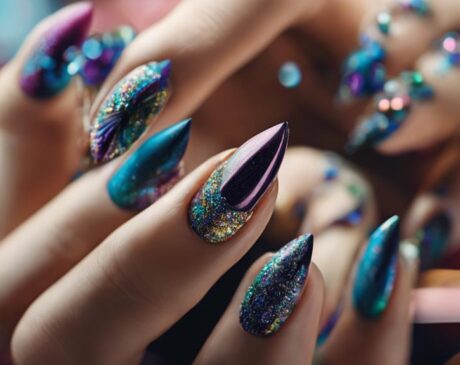How Do I Know if My Nail Tech Is Bad?
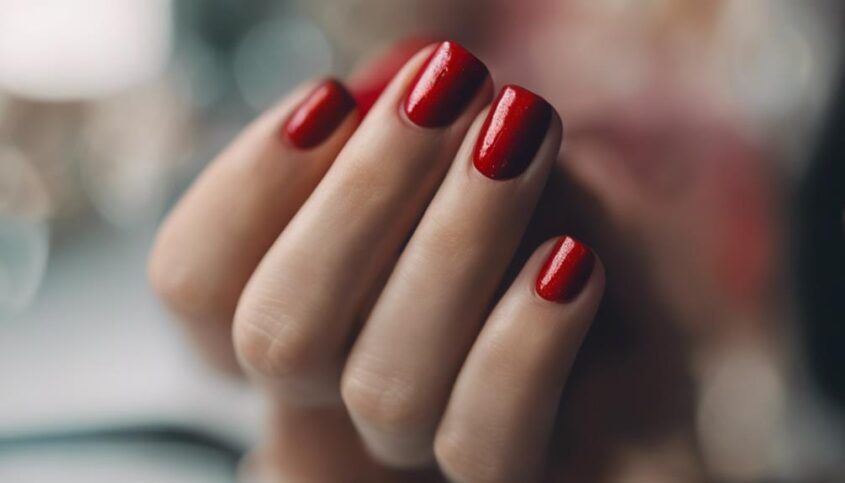
Signs of a bad nail tech include neglecting nail health, rushing through services compromising quality, and poor hygiene practices risking infections. Limited nail design skills, use of low-quality products, and ignoring client preferences are red flags. Professionalism lapses like poor time management and inattentiveness are indicators. Ensuring a skilled, hygienic technician who prioritizes your nail health is essential for a satisfying experience.
Key Takeaways
- Neglecting nail health can lead to infections and brittle nails.
- Rushing compromises quality and attention to detail.
- Poor hygiene can lead to serious health risks.
- Limited nail design skills can indicate a lack of expertise.
- Using low-quality products can damage nails and lead to subpar results.
Inattentive to Nail Health
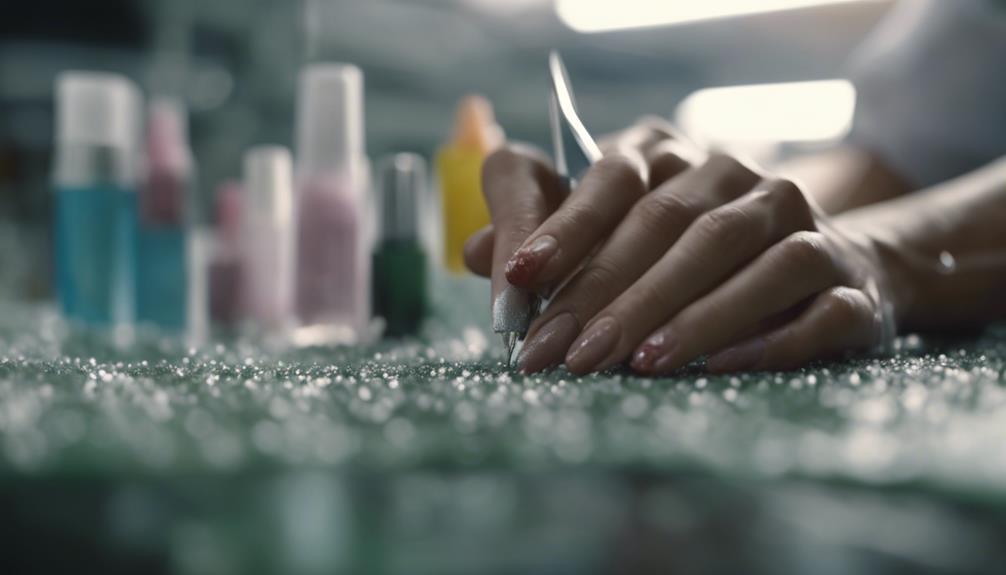
One of the key indicators of a bad nail tech is their lack of attentiveness to nail health. A proficient nail technician understands the importance of maintaining nail health as the foundation for beautiful and long-lasting manicures. Neglecting nail health not only compromises the overall appearance of nails but can also lead to various issues such as infections, brittle nails, or even more severe conditions. Innovation in nail care involves staying updated on the latest techniques, products, and technologies that promote nail health and enhance the overall nail care experience.
A skilled nail technician should demonstrate a keen interest in assessing the condition of a client's nails, offering personalized recommendations, and providing education on proper nail care practices. By being attentive to nail health, a nail tech can proactively address any concerns, prevent potential problems, and ensure that every client leaves with healthy, beautiful nails. Clients seeking innovative nail services should prioritize technicians who prioritize nail health as a fundamental aspect of their practice.
Rushes Through Services
Ensuring quality service and attention to detail are hallmarks of a skilled nail technician; however, a concerning trait in a nail tech is when they rush through services without thorough care and precision. Rushing through services not only compromises the quality of the manicure or pedicure but also raises red flags regarding the technician's professionalism and dedication to client satisfaction.
When a nail technician rushes through a service, they are more likely to overlook crucial steps such as proper nail preparation, cuticle care, and ensuring precise polish application. This can result in uneven nail lengths, messy cuticles, and polish that chips easily. Clients may leave the salon feeling dissatisfied and frustrated with the results, leading to a negative perception of the technician's skills.
To maintain a positive reputation and build a loyal clientele, nail technicians must prioritize quality over speed. Taking the time to deliver meticulous services demonstrates a commitment to excellence and ensures that clients leave feeling pampered and pleased with the results.
Poor Hygiene Practices
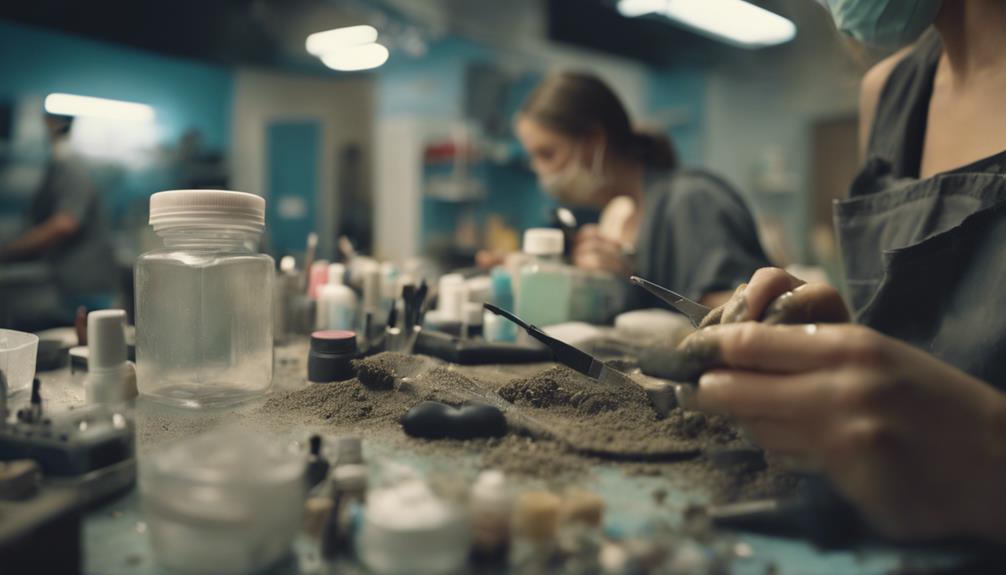
Maintaining high standards of hygiene in a nail salon is essential for both the safety and satisfaction of clients. A nail technician's poor hygiene practices can lead to serious health risks, including bacterial and fungal infections. Clients expect a clean and sanitary environment when they visit a salon, and any deviation from this standard can result in a loss of trust and reputation. Common signs of poor hygiene practices include the improper cleaning and disinfection of tools, the reuse of disposable items, and the lack of hand washing or glove usage.
To ensure a safe and hygienic experience, reputable nail technicians should follow strict protocols for sanitizing tools, implements, and work surfaces between clients. They should also use disposable items where necessary and maintain a high level of personal hygiene. By prioritizing cleanliness and infection control, nail technicians can provide a professional service that meets the expectations of their clients and upholds the reputation of the salon.
Limited Nail Design Skills
In addition to maintaining proper hygiene practices, another crucial aspect to consider when evaluating a nail technician's proficiency is their level of expertise in nail design skills. A skilled nail technician should not only be able to execute basic nail designs but also demonstrate creativity and proficiency in more intricate and trendy designs. Clients seeking innovative and unique nail art expect their nail tech to stay updated on the latest trends and techniques in the industry. The ability to flawlessly execute a wide range of designs, from minimalist chic to elaborate and detailed nail art, showcases a nail technician's artistic flair and attention to detail. Limited nail design skills can manifest in an inability to bring clients' ideas to life or in the execution of designs that lack precision and creativity. Therefore, when assessing a nail tech's competence, it is essential to consider their proficiency and creativity in nail design as a key indicator of their overall skill level.
Uses Low-Quality Products
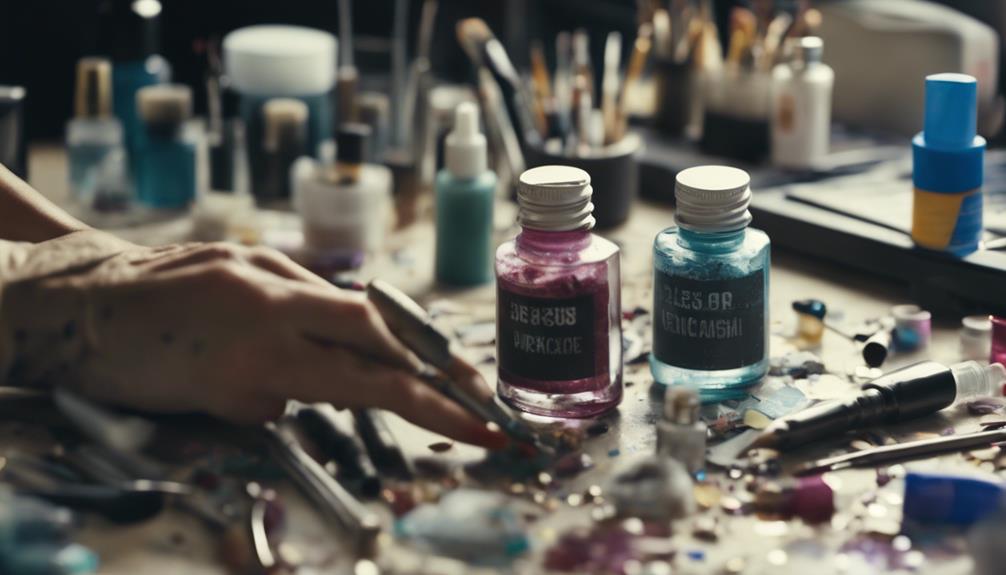
When it comes to nail services, the quality of products used can significantly impact the final results. It is crucial to pay attention to the products your nail tech uses as low-quality items can lead to subpar outcomes and potential damage to your nails. Recognizing red flags in the quality of products being used can help you make informed decisions about the nail tech you choose.
Product Quality Matters
Quality nail technicians prioritize using high-grade products that enhance the overall health and appearance of nails. When a nail tech uses low-quality products, it can lead to various issues like chipping, discoloration, or even nail damage. Here is a comparison to illustrate the importance of product quality:
| Aspect | High-Quality Products | Low-Quality Products |
|---|---|---|
| Durability | Long-lasting and resistant to chipping | Prone to chipping and wearing off quickly |
| Appearance | Provides a glossy and professional finish | May look dull and lackluster |
| Nail Health | Nourishes and strengthens nails | Could contain harmful chemicals harming nail health |
Recognizing Red Flags
To identify a bad nail tech, one must be vigilant for signs that indicate the use of low-quality products, which can compromise the health and appearance of nails. One red flag to watch out for is the use of cheap or unknown brands of nail polishes, acrylics, gels, and other products. These low-quality products may contain harmful chemicals that can weaken nails, cause allergic reactions, or lead to infections. Additionally, inferior products often result in a less durable and aesthetically pleasing manicure or pedicure. A skilled and reputable nail tech will typically use high-quality, trusted brands that prioritize the health and safety of their clients' nails. By being aware of the products your nail tech uses, you can ensure a safer and more satisfactory nail care experience.
Unsanitary Tools and Equipment
Ensuring the cleanliness and proper maintenance of tools and equipment is essential in distinguishing a good nail tech from a bad one. Hygiene practices not only reflect professionalism but also protect clients from infections and other health risks. A reputable nail technician understands the importance of sanitization and invests in high-quality tools to deliver safe and top-notch services.
To help you identify if your nail tech is maintaining the required standards, here are some signs of unsanitary tools and equipment you should watch out for:
| Signs of Unsanitary Tools and Equipment | Description |
|---|---|
| Rusty tools | Indicates poor maintenance and can cause infections |
| Dirty nail files | Can transfer bacteria and fungi between clients |
| Improperly sterilized equipment | Raises the risk of infections and cross-contamination |
| Used cotton balls left on the table | Shows lack of cleanliness and attention to detail |
| Cracked or chipped nail polish bottles | May contain dried residue and harbor bacteria |
Disregards Client Preferences

When a nail technician disregards client preferences, it can lead to dissatisfaction. Ignoring the client's desired nail shape, rushing through the service, or using products that the client specifically requested to avoid can all contribute to a negative experience. A good nail tech should prioritize understanding and fulfilling the client's preferences to provide a satisfactory service.
Ignores Nail Shape
A telltale sign of a bad nail tech is when they disregard the client's preferred nail shape during a manicure session. Nail shape is a crucial aspect of a manicure as it greatly influences the overall look and feel of the nails. Ignoring a client's desired nail shape shows a lack of attention to detail and a failure to prioritize client preferences. A professional nail tech should always consult with the client to understand their preferences and ensure that the final result aligns with the client's vision. Ignoring nail shape can lead to dissatisfaction and a disconnect between the client and the service provider.
| Common Nail Shapes | Description |
|---|---|
| Square | Straight sides with sharp corners |
| Round | Gentle curve at the edges |
| Oval | Rounded edges with an elongated shape |
| Almond | Tapered sides with a rounded tip |
| Stiletto | Pointed tip resembling a stiletto heel |
Rushes Through Service
Neglecting to allocate sufficient time and attention to each client's specific preferences is a clear indication of a subpar nail technician. Rushing through a service can lead to dissatisfaction and potential mistakes that could have been avoided with proper care and consideration. When a nail tech rushes through a service, they often:
- Fail to consult with the client on their desired nail design or style.
- Skip essential steps in the nail care process, compromising the final result.
- Disregard the client's comfort or concerns during the service.
To ensure a positive experience and quality outcome, it is crucial for nail technicians to prioritize each client's preferences and provide a thorough and unhurried service.
Uses Wrong Products
In the realm of nail care services, the use of incorrect products, particularly when disregarding client preferences, can significantly impact the overall quality of the service provided. Nail technicians who fail to consider their clients' preferences risk causing dissatisfaction and potential harm. Using the wrong products may lead to allergic reactions, poor adhesion, or premature chipping of the polish, all of which can tarnish the client's experience. A skilled nail technician should prioritize understanding and adhering to the client's product preferences to ensure a personalized and satisfactory service. By valuing client input and utilizing suitable products, nail technicians can demonstrate their commitment to delivering high-quality, innovative nail care services that meet individual needs and preferences.
Lack of Professionalism
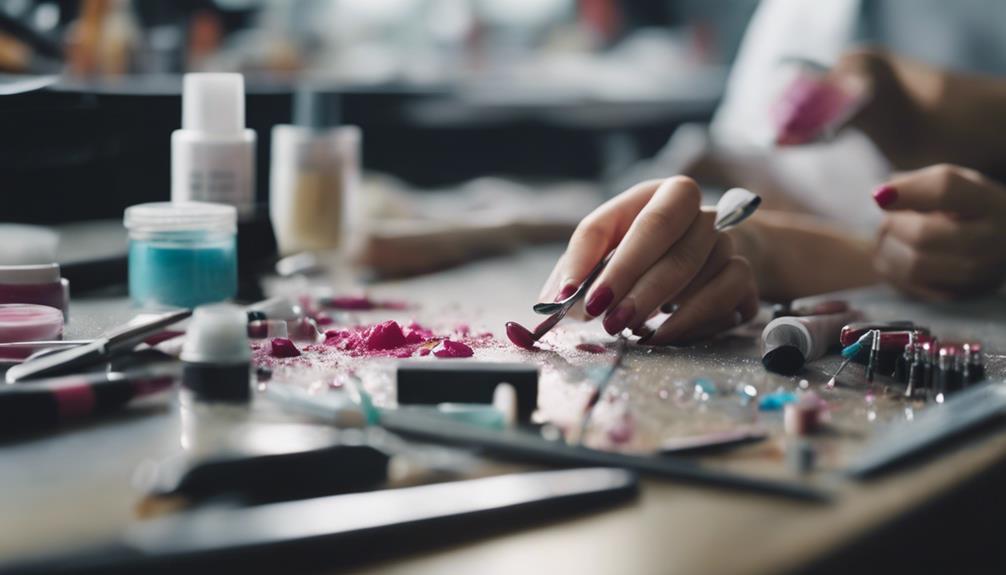
Demonstrating a lack of professional demeanor, such as arriving late or being dismissive of client concerns, can be key indicators of a bad nail tech. Professionalism is crucial in the beauty industry as it reflects the technician's commitment to their craft and client satisfaction. Here are three signs that your nail tech may be lacking professionalism:
- Poor Time Management: Constantly running behind schedule or making clients wait without valid reasons can be frustrating and disrespectful.
- Inattentiveness to Client Preferences: Ignoring or disregarding the client's requests and preferences shows a lack of respect for their individual needs.
- Failure to Maintain a Clean Workspace: A disorganized and unclean work environment not only reflects poorly on the technician's professionalism but can also raise hygiene concerns.
Recognizing these behaviors can help you make informed decisions about continuing services with a nail tech who may not prioritize professionalism.
Frequently Asked Questions
Can a Bad Nail Tech Cause Long-Term Damage to My Nails?
A bad nail tech can indeed cause long-term damage to your nails. Poor techniques, unsanitary practices, and the use of subpar products can lead to issues such as nail infections, weakened nails, and even permanent damage if not addressed promptly.
How Do I Know if a Nail Tech Is Using Unsanitary Tools and Equipment?
To determine if a nail tech is using unsanitary tools and equipment, observe their sterilization practices, inquire about their disinfection procedures, assess the cleanliness of their workspace, and ensure disposable tools are used when appropriate.
Are There Any Red Flags to Look Out for When Determining if a Nail Tech Has Poor Hygiene Practices?
Maintaining meticulous hygiene in nail care is akin to safeguarding a garden; vigilant observation of cleanliness practices, such as proper tool sterilization, avoiding cross-contamination, and maintaining a tidy workspace, is crucial for botanical beauty to flourish.
What Steps Can I Take to Address a Nail Tech Who Disregards My Preferences During a Service?
To address a nail tech who disregards your preferences during a service, initiate a calm conversation outlining your expectations. Clearly communicate your needs and concerns, allowing the tech to adjust their approach. If issues persist, consider seeking services elsewhere for a better match.
What Are the Potential Risks of Using Low-Quality Nail Products on My Nails?
Using low-quality nail products can lead to various risks such as nail infections, allergic reactions, weakened nails, and overall poor nail health. Opting for high-quality products ensures better results and minimizes potential harm.


